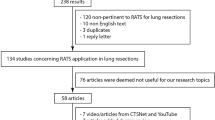Abstract
Currently, transoral robotic surgery (TORS) with the daVinci robot is mainly used for squamous cell carcinoma of the oropharynx and supraglottic larynx. The safety, efficacy, and functional outcomes regarding this approach have previously been described. In addition to transoral resection of squamous cell carcinoma, we have found use for this technique in removing selected tumors of the parapharyngeal space. Three patients with benign or malignant tumors of the parapharyngeal space who underwent successful transoral resection using the daVinci robot were included in the study. In all three cases, complete tumor excision was achieved without any complication. None required conversion to an open procedure. Mean TORS operative time and intraoperative blood loss were 16.3 min and 4.7 mL, respectively. Inadequate oral exposure, involvement of the internal carotid artery, limited cervical spine mobility and large tumor size are the main limitations of this approach. Result indicates that magnified view, 3D visualization with the combination of the transoral robotic experience, allow en bloc resection of selected parapharyngeal space tumors located medial to the carotid sheath.






Similar content being viewed by others
References
Weinstein GS, O’Malley BW Jr, Snyder W, Sherman E, Quon H (2007) Transoral robotic surgery: radical tonsillectomy. Arch Otolaryngol Head Neck Surg 133:1220–1226
Weinstein GS, Quon H, O’Malley BW Jr, Kim GG, Cohen MA (2010) Selective neck dissection and deintensified postoperative radiation and chemotherapy for oropharyngeal cancer: a subset analysis of the University of Pennsylvania transoral robotic surgery trial. Laryngoscope 120:1749–1755
O’Malley BW Jr, Weinstein GS (2007) Robotic skull base surgery: preclinical investigations to human clinical application. Arch Otolaryngol Head Neck Surg 133:1215–1219
Park YM, Lee WJ, Lee JG, Lee WS, Choi EC, Chung SM, Kim SH (2009) Transoral robotic surgery (TORS) in laryngeal and hypopharyngeal cancer. J Laparoendosc Adv Surg Tech A 19:361–368
Ozer E, Waltonen J (2008) Transoral robotic nasopharyngectomy: a novel approach for nasopharyngeal lesions. Laryngoscope 118:1613–1616
O’Malley BW Jr, Quon H, Leonhardt FD, Chalian AA, Weinstein GS (2010) Transoral robotic surgery for parapharyngeal space tumors. ORL J Otorhinolaryngol Relat Spec 72:332–336
Conflict of interest
The authors declare that they have no conflict of interest.
Author information
Authors and Affiliations
Corresponding author
Rights and permissions
About this article
Cite this article
Arshad, H., Durmus, K. & Ozer, E. Transoral robotic resection of selected parapharyngeal space tumors. Eur Arch Otorhinolaryngol 270, 1737–1740 (2013). https://doi.org/10.1007/s00405-012-2217-y
Received:
Accepted:
Published:
Issue Date:
DOI: https://doi.org/10.1007/s00405-012-2217-y




